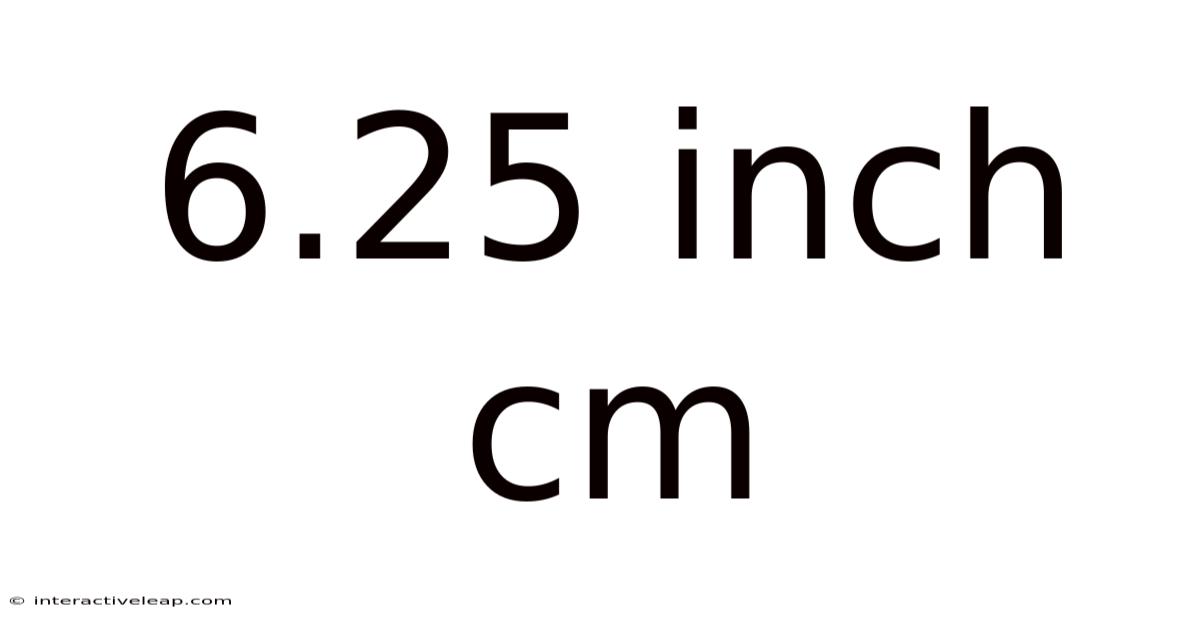6.25 Inch Cm
interactiveleap
Sep 20, 2025 · 4 min read

Table of Contents
Decoding 6.25 Inches: A Deep Dive into Measurements and Applications
Understanding measurements is fundamental to numerous fields, from engineering and design to everyday life. This article delves into the specifics of 6.25 inches, exploring its conversion to centimeters, its practical applications across various industries, and addressing common questions surrounding this specific measurement. Whether you're a student grappling with metric conversions, a DIY enthusiast working on a project, or simply curious about the world of measurements, this comprehensive guide will equip you with a thorough understanding of 6.25 inches (and its centimeter equivalent).
Introduction: Why 6.25 Inches Matters
6.25 inches, or 15.875 centimeters, might seem like an arbitrary measurement, but its prevalence across various applications highlights its significance. This seemingly small measurement plays a crucial role in numerous contexts, from the dimensions of electronic devices to the precise calculations needed in construction and engineering. Understanding its implications and conversions is essential for anyone working with these fields. This article will clarify the conversion process, explore its relevance in different industries, and dispel any misconceptions about this particular measurement.
Converting 6.25 Inches to Centimeters: A Step-by-Step Guide
The conversion from inches to centimeters is straightforward, utilizing the fundamental conversion factor: 1 inch = 2.54 centimeters. To convert 6.25 inches to centimeters, we simply multiply:
6.25 inches * 2.54 centimeters/inch = 15.875 centimeters
Therefore, 6.25 inches is equivalent to 15.875 centimeters. This calculation is crucial for ensuring accuracy and consistency across different measurement systems. The precise conversion is essential in situations demanding high precision, such as manufacturing or engineering projects.
Practical Applications of 6.25 Inches: Across Industries
The 6.25-inch measurement, while seemingly specific, finds widespread applications in several industries:
-
Electronics: Many electronic devices, particularly smartphones and tablets, have dimensions incorporating 6.25 inches or multiples thereof. This measurement might represent the diagonal screen size, the width or height of the device, or even the length of internal components. The precise sizing is crucial for optimal user experience and device functionality.
-
Construction and Manufacturing: While not as prevalent as other measurements, 6.25 inches or its multiples often appear in detailed architectural plans or mechanical designs. This could be in the form of specific component dimensions, spacing requirements, or overall structural elements. Accuracy is paramount in these applications, making the conversion to centimeters equally important.
-
Woodworking and DIY Projects: DIY enthusiasts and carpenters frequently encounter this measurement. A 6.25-inch piece of wood might be required for a specific project, necessitating accurate cutting and measurements. The use of both imperial and metric measurements in woodworking necessitates a thorough understanding of conversions.
-
Automotive: While not as common as larger measurements, certain automotive components might utilize 6.25 inches in their specifications. This could involve specific internal parts, wiring harnesses, or specialized attachments. Precision in this industry is vital for safety and performance.
The Importance of Precision in Measurement: Minimizing Errors
Using the correct conversion factor (2.54 cm/inch) is crucial to maintain accuracy. Rounding off the result (15.875 cm) to 16 cm, while seemingly insignificant, can lead to cumulative errors in projects requiring high precision. This is especially important in fields such as engineering and manufacturing, where minute discrepancies can have significant consequences.
Common Misconceptions about 6.25 Inches
A common misconception is the interchangeability of inches and centimeters without precise conversion. It's important to remember that these are distinct units of measurement with a fixed conversion rate. Approximations should be avoided, particularly in scenarios demanding accuracy.
Frequently Asked Questions (FAQ)
-
Q: Why is 6.25 inches a relatively common measurement?
-
A: While not as ubiquitous as whole numbers, 6.25 inches often arises from fractional calculations and subdivisions of larger measurements. It's a byproduct of various design and engineering processes.
-
Q: How do I accurately measure 6.25 inches?
-
A: Use a ruler or measuring tape with clear inch and fractional markings. Ensure your measuring tool is calibrated correctly for accurate results.
-
Q: What is the difference between 6.25 inches and 6.25 centimeters?
-
A: 6.25 inches is a significantly larger measurement than 6.25 centimeters. Remember the conversion factor: 1 inch = 2.54 centimeters. 6.25 inches is approximately 15.875 centimeters.
-
Q: Is it necessary to convert inches to centimeters in all cases?
-
A: The necessity for conversion depends on the project and the required precision. While some projects might tolerate approximate measurements, others require precise conversions to maintain accuracy.
Mathematical Exploration of 6.25 Inches
6.25 inches can be expressed as a fraction: 25/4 inches. This fractional representation highlights its origin as a division of a larger whole number, explaining its appearance in various contexts. Understanding this fractional representation can simplify calculations involving this specific measurement.
Conclusion: Mastering Measurements for Success
Understanding measurements, particularly the conversion between inches and centimeters, is critical across numerous disciplines. This detailed examination of 6.25 inches, its conversion, applications, and common misconceptions, emphasizes the importance of precision and accuracy in measurement. Whether you're a professional engineer, a DIY enthusiast, or a student learning about measurement systems, mastering these concepts ensures success in your endeavors. Remember to always prioritize accurate conversions and utilize appropriate measuring tools for optimal results. The seemingly insignificant 6.25 inches highlights the critical role of precision in various aspects of life and work. By understanding its nuances, we enhance our ability to tackle projects with confidence and accuracy.
Latest Posts
Latest Posts
-
65 Cm Feet
Sep 20, 2025
-
Translate By Vector
Sep 20, 2025
-
3 20 As Decimal
Sep 20, 2025
-
Jeans With Blue
Sep 20, 2025
-
19 2 X Pi
Sep 20, 2025
Related Post
Thank you for visiting our website which covers about 6.25 Inch Cm . We hope the information provided has been useful to you. Feel free to contact us if you have any questions or need further assistance. See you next time and don't miss to bookmark.